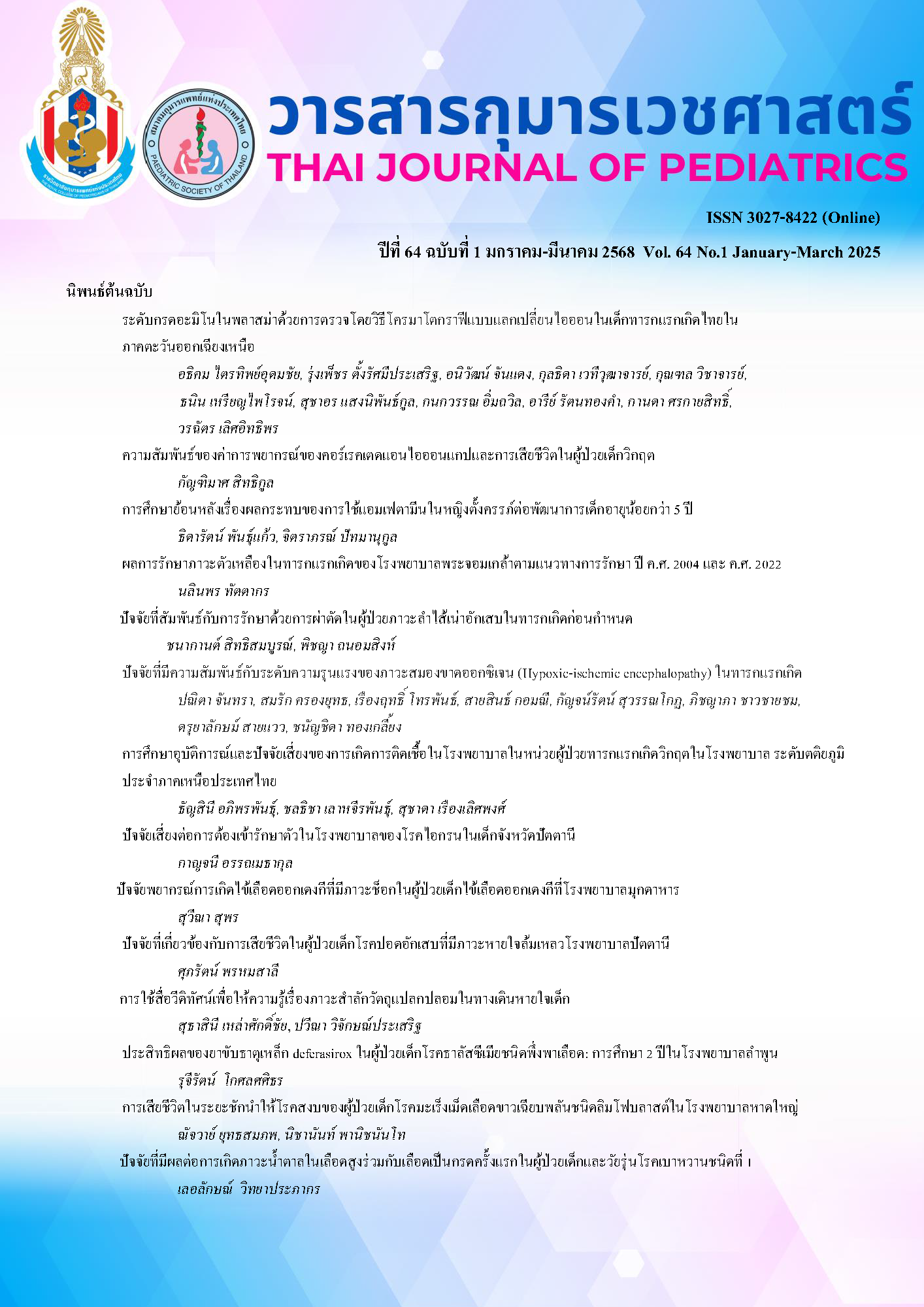ปัจจัยที่เกี่ยวข้องกับการเสียชีวิตในผู้ป่วยเด็กโรคปอดอักเสบที่มีภาวะหายใจล้มเหลวโรงพยาบาลปัตตานี
คำสำคัญ:
Pneumonia, Acute respiratory failure, Respiratory acidosis, Hypercapnia, Congenital heart defect, Respiratory distress syndromeบทคัดย่อ
ความสำคัญ: โรคปอดอักเสบเป็นโรคติดเชื้อระบบทางเดินหายใจที่เป็นสาเหตุการเสียชีวิตในเด็กอันดับ 1 ของโลก โดยเฉพาะในกลุ่มเด็กเล็กที่มีอายุน้อยกว่า 5 ปี และโรคปอดอักเสบเป็นสาเหตุหลักของการเกิดภาวะหายใจล้มเหลวในเด็กในจังหวัดปัตตานี และมีอัตราการเสียชีวิตจากโรคปอดอักเสบในเด็กสูงที่สุดในเขตสุขภาพเดียวกัน การทราบปัจจัยที่อาจมีผลต่อความรุนแรงของโรคและเพิ่มโอกาสเสี่ยงเสียชีวิต จะมีประโยชน์ในการเฝ้าระวัง และพัฒนาการดูแลรักษาในผู้ป่วยกลุ่มนี้เพื่อช่วยลดอัตราการเสียชีวิตได้
วัตถุประสงค์: เพื่อวิเคราะห์ปัจจัยที่มีความสัมพันธ์กับอัตราการเสียชีวิตในผู้ป่วยเด็กโรคปอดอักเสบรุนแรงที่มีภาวะหายใจล้มเหลว
วิธีการศึกษา: เป็นการศึกษาเชิง prognostic factor research รูปแบบ retrospective case-control design ที่กลุ่มงานกุมารเวชกรรม โรงพยาบาลปัตตานี ศึกษาในผู้ป่วยเด็กอายุ 1 เดือน ถึง 15 ปีที่ได้รับการวินิจฉัยว่าเป็นโรคปอดอักเสบและมีภาวะหายใจล้มเหลวที่ต้องใช้เครื่องช่วยหายใจ ตั้งแต่ 1 มกราคม 2563 ถึง 31 ธันวาคม 2566 ค้นหาข้อมูลผู้ป่วยเด็กโรคปอดอักเสบที่มีภาวะหายใจล้มเหลวเสียชีวิต (case) และสุ่มผู้ป่วยเด็กที่ไม่เสียชีวิต (control) ในวันที่พบ case จากฐานข้อมูลเดียวกัน สืบค้นข้อมูลจากบันทึกเวชระเบียนผู้ป่วย ใบส่งต่อผู้ป่วยจากโรงพยาบาลชุมชน และ จาก program HosXP ของโรงพยาบาล เปรียบเทียบปัจจัยทั้ง 2 กลุ่มด้วย exact probability test และวิเคราะห์ลักษณะพยากรณ์ด้วย generalized linear model (risk difference (RD), 95% confidence interval [CI])
ผลการศึกษา: ผู้ป่วยเด็กโรคปอดอักเสบและมีภาวะหายใจล้มเหลวที่ต้องใช้เครื่องช่วยหายใจ 70 ราย เสียชีวิต 10 ราย (ร้อยละ 14.3) มีลักษณะที่อาจจะเป็นปัจจัยเสี่ยงที่ทำให้เสียชีวิต 15 ปัจจัย เมื่อวิเคราะห์แบบ multivariable regression แล้ว ปัจจัยที่ยังคงมีนัยสำคัญทางสถิติ ได้แก่ การมีโรคหัวใจพิการแต่กำเนิด (RD 0.39, 95% CI 0.054, 0.734) การมีภาวะเลือดเป็นกรดตั้งแต่แรกรับ (VBG pH <7.3) (RD 0.24, 95% CI 0.044, 0.439) ภาวะคั่งของก๊าซคาร์บอนไดออกไซด์ในเลือดตั้งแต่แรกรับ (VBG pCO2 >50 mEq/L) (RD 0.44, 95% CI 0.071, 0.810)
สรุป: ผู้ป่วยเด็กโรคปอดอักเสบที่มีภาวะหายใจล้มเหลวและใช้เครื่องช่วยหายใจ มีโอกาสเสียชีวิตสูงขึ้นหากผู้ป่วยมีโรคประจำตัวเป็นโรคหัวใจพิการแต่กำเนิด มีภาวะเลือดเป็นกรด หรือ มีภาวะคั่งของก๊าซคาร์บอนไดออกไซด์ในเลือดตั้งแต่แรกรับ ดังนั้นควรให้การรักษาอย่างทันท่วงที และเฝ้าติดตามอาการอย่างใกล้ชิดในผู้ป่วยกลุ่มนี้
Downloads
เอกสารอ้างอิง
Li Y, An Z, Yin D, Liu Y, Huang Z, Ma Y, et al. Disease burden of community acquired pneumonia among children under 5 y old in China: A population based survey. Hum Vaccines Immunother. 2017;131681–7.
Dong YY, Zhang L, Yang YL, Dong W, Mo DD, Fang Y, et al. A comparative study on children’s basic medical insurance system and policies in four municipalities in China. J Shanghai Jiaotong Univ Med Sci. 2018;38:670–5.
Shan W, Shi T, Chen K, Xue J, Wang Y, Yu J, et al. Risk factors for severe community-aquired pneumonia among children hospitalized with CAP younger than 5 years of age. Pediatr Infect Dis J. 2019;38224–9.
Wang J, Xu ZH, Lu J. Hospitalization costs for children with pneumonia in Shanghai, China from 2019 to 2020. Hum Vaccines Immunother. 2022;18:2081459.
Goyal JP, Kumar P, Mukherjee A, Das RR, Bhat JI, Ratageri V, et al. Risk factors for the development of pneumonia and severe pneumonia in children. Indian Pediatr. 2021;58:1036–9.
กรมควบคุมโรค กระทรวงสาธารณสุข, สถานการณ์โรคปอดอักเสบ. 2566. [อินเตอร์เน็ต]. สืบค้นเมื่อ 3 พฤศจิกายน 2566. แหล่งข้อมูล:https://ddc.moph.go.th/disease_detail.php?d=21.
กองโภชนาการ กรมอนามัย กระทรวงสาธารณสุข. เกณฑ์อ้างอิง น้ำหนัก ส่วนสูง และเครื่องชี้วัดภาวะโภชนาการของประชาชนไทย อายุ 1 วัน - 19 ปี. (อินเตอร์เน็ต). 2543 (เข้าถึงเมื่อ 7 ก.ค. 2567). เข้าถึงได้จาก: https://nutrition2.anamai.moph.go.th
WHO MULTICENTRE GROWTH REFERENCE STUDY GROUP, De Onis M. WHO Child Growth Standards based on length/height, weight and age. Acta Paediatr. 2006;95:76–85.
The impact of childhood malnutrition on mortality from pneumonia: A systematic review and network meta-analysis - World | ReliefWeb [Internet]. 2021 [cited 2024 Jul 9]. Available from: https://reliefweb.int/report/world/impact-childhood-malnutrition-mortality-pneumonia-systematic-review-and-network-meta
Cao L, Ji Z, Zhang P, Wang J. Epidemiology and mortality predictors for severe childhood community-acquired pneumonia in ICUs: A retrospective observational study. Front Pediatr [Internet].2023 Mar 23 [cited 2024 Jul 7];11. Available from: https://www.frontiersin.org/journals/pediatrics/articles/10.3389/fped.2023.1031423/full
Diller GP, Enders D, Lammers AE, Orwat S, Schmidt R, Radke RM, et al. Mortality and morbidity in patients with congenital heart disease hospitalised for viral pneumonia. Heart. 2021;107:1069–76.
Wilkes C, Bava M, Graham HR, Duke T. What are the risk factors for death among children with pneumonia in low- and middle-income countries? A systematic review. J Glob Health. 2023;24:13:05003.
Publisher E. World Health Organization - Regional Office for the Eastern Mediterranean. [cited 2025 Feb 24]. Prematurity. Available from: http://www.emro.who.int/child-adolescent-health/newborn-health/prematurity.html
Ress KL, Koerbin G, Li L, Chesher D, Bwititi P, Horvath AR. Reference intervals for venous blood gas measurement in adults. Clin Chem Lab Med CCLM. 2021 Apr 27;59(5):947–54.
Razi E, Nasiri O, Akbari H, Razi A. Correlation of Arterial Blood Gas Measurements with Venous Blood Gas Values in Mechanically Ventilated Patients. Tanaffos. 2012;11(4):30–5.
Oi I, Ito I, Tanabe N, Konishi S, Ibi Y, Hidaka Y, et al. Investigation of predictors for in-hospital death or long-term hospitalization in community-acquired pneumonia with risk factors for aspiration. Eur Clin Respir J. 2024;11:2335721
Araya S, Lovera D, Zarate C, Apodaca S, Acuña J, Sanabria G, et al. Application of a prognostic scale to estimate the mortality of children hospitalized with community-acquired pneumonia. Pediatr Infect Dis J. 2016;35:369–73.
Goldstein B, Giroir B, Randolph A. International pediatric sepsis consensus conference: Definitions for sepsis and organ dysfunction in pediatrics. Pediatr Crit Care Med. 2005;6:2–8.
Atwa Z. Usefulness of gender and abnormal blood count for predicting pneumonia outcome in children. Egypt J Chest Dis Tuberc. 2015;64:169–74.
Gallagher PG. Anemia in the pediatric patient. Blood. 2022;140:571–93.
Jakhar SK, Pandey M, Shah D, Ramachandran VG, Saha R, Gupta N, et al. Etiology and risk factors determining poor outcome of severe pneumonia in under–five children. Indian J Pediatr. 2018;85:20–4.
Djelantik IGG, Gessner BD, Sutanto A, Steinhoff M, Linehan M, Moulton LH, et al. Case fatality proportions and predictive factors for mortality among children hospitalized with severe pneumonia in a rural developing country setting. J Trop Pediatr. 2003;49:327–32.
ดาวน์โหลด
เผยแพร่แล้ว
รูปแบบการอ้างอิง
ฉบับ
ประเภทบทความ
สัญญาอนุญาต
ลิขสิทธิ์ (c) 2025 ราชวิทยาลัยกุมารแพทย์แห่งประเทศไทย และ สมาคมกุมารแพทย์แห่งประเทศไทย

อนุญาตภายใต้เงื่อนไข Creative Commons Attribution-NonCommercial-NoDerivatives 4.0 International License.



